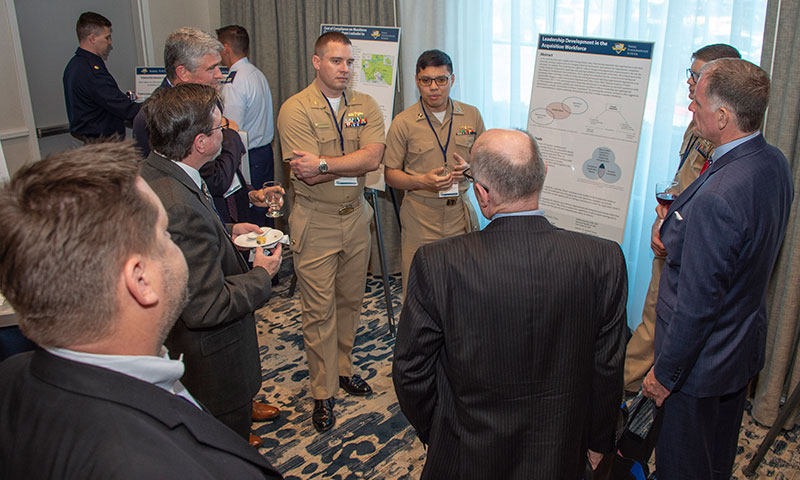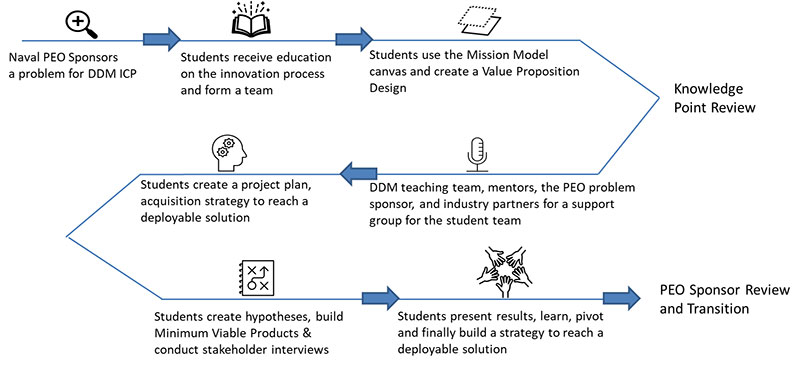The Naval Postgraduate School (NPS) is currently piloting a new innovation capstone opportunity for NPS’ warrior-scholar students to work with U.S. Navy sponsors on developing and transitioning their innovative ideas within the space of a year. Through practical experiential learning with an intentional focus on relevant technological innovation transition and adoption, NPS students will gain the ability to lead through uncertainty, as well as the knowledge and requisite skills to leverage technologies for innovative solutions to operational problems.
Moving concepts from idea to impact is ultimately how innovation will be judged. The Innovation Capstone Project (ICP) is a new program that enables interdisciplinary student teams with varied technical research and acquisitions backgrounds to collaborate on a project to meet a capability requirement. Together, the teams prepare and move proposals to a point where they’re pitching their capstone ideas to a panel of military, industry and acquisitions experts. Those with the most compelling solutions and transition plans will be selected to move forward into the next phase of rapid prototyping and development with the acquisition community.
Raymond Jones, chair of the Department of Defense Management (DDM), is currently working with four pilot capstone teams. His pilot program is giving these teams the opportunity to move beyond a thesis to expose these students to the entire innovation cycle. Jones sees innovation as a skill set that is best learned through working on real-life innovative projects in collaboration with command sponsors.
“The point of this capstone is to take all the great work being done around the NPS campus and put it into a pathway that moves it forward. Think of it like ‘Shark Tank’ for the Navy,” said Jones, referring to the popular TV show where contestants pitch their business ideas to investors. “We are developing our military students’ ability to lead innovation informed by their operational experience and transition their good ideas to solve real operational problems.”
Effective solutions must involve the fleet – and increasingly, partners in industry, where much of today’s technology innovation is occurring.
Last year the Secretary of the Navy, Carlos Del Toro, directed the establishment of a Naval Innovation Center at NPS, “right in the heart of our nation’s leading technology corridor.” Said Del Toro: “This will serve as a premier military education facility tailored to innovation and experimentation, serving as a technology resource for Navy and Marine Corps warfighting development commands, as well as a go-to partner of the defense industrial base, the technology sector, and academia.”
The ICP is the final phase of the innovation operating concept at NPS that notionally begins with the annual year-long campaign of analysis called the Warfare Innovation Continuum (WIC), centered on a single overarching naval warfighting theme. This year’s theme was the Future Hybrid Force.
From the WIC, students and faculty research ideas are often further developed, some through Naval Innovation Exchange teams that will involve industry partners to create minimum viable products and can also be tested in operationally relevant environments.
Too often, said Jones, defense capabilities are designed and engineered in a lab without consideration of real-world application or the complex defense acquisition and management processes needed to develop and deliver technical solutions to the warfighter. Jones sees the ICP as a catalyst for accelerating innovation.
“We’re creating a framework that allows all of these ideas – regardless of the department or curriculum initiating them – to be supported by teams that can move them forward quickly,” Jones continued. “We bring the teams together and provide a pathway to what are in essence the ‘venture capitalists’ that can move the products back to the end-user.”
Integrating acquisition expertise throughout the development process creates more realistically-deliverable outcomes, and expedites the speed at which innovations can be deployed. Connecting technical and acquisition expertise is key to bridging the infamous “valley of death” – a term that acknowledges the lengthy timelines from shifting prototypes into funded programs of record that can move into production.
NPS is one of 24 naval centers of innovation – and the only one that has a defense research university mission and is a designated defense laboratory. Dr. Kevin Smith, NPS Vice Provost for Research, leads the Officer of Research and Innovation, where he is working with Jones to integrate the ICP into the Navy’s broader research and development community.
“NPS has long offered deep faculty expertise in defense academic research, often co-developed with our students, which fuels the education and innovation at NPS,” said Smith. “What’s needed is the bridge that connects the NPS ecosystem of students, faculty and industry partners directly to the naval acquisition community’s decision-makers to speed transition. This new Innovation Capstone Project will enable that to happen.”
Key to success is the step-by-step capstone approach, where real requirements are matched with ideas emerging from the WIC as well as direct fleet input through the Naval Warfare Studies Institute at NPS. Over the first three months of the ICP, the students go through courses focused on innovation and then prepare a proposal for the first checkpoint.
The capstone proposal extends beyond normal student thesis requirements in that it must include an acquisition strategy. Their proposal is put in front of a mixed panel that can include faculty who determine if it meets departmental standards; naval officers who will decide if the proposal meets operational needs; and Program Executive Officers (PEOs) from the acquisition community, who in this process are the Navy’s “Shark Tank venture capitalists.” In this case, they are determining not just payoff, but the potential to meet warfighting needs aligned to critical enabling capabilities identified in the CNO’s Navigation Plan (NAVPLAN).
In additional to technical merit, student proposals must also offer solutions to contracting strategies for development, production and sustainment. Many students at NPS in DDM take advantage of the Acquisition Research Program (ARP), now in its 20th year, which provides ongoing policy analysis and recommendations to defense officials on procurement, as well as a core competency in acquisition at NPS for ICP teams to leverage. In doing so, students' projects will be better informed to meet acquisition gateways as they collaborate with industry.
Jones looks to small companies that don’t always have the resources or experience to take part in large DOD projects and see the value in working directly with NPS student teams facilitated through Cooperative Research and Development Agreements (CRADAs). NPS has nearly 40 industry CRADAs addressing relevant research and technology needs.
The second and last checkpoint is the final ICP review board. The inaugural board will take place this November, when Jones will invite the Secretary of the Navy and the Assistant Secretary of the Navy for Research, Development and Acquisition (ASN RD&A) to join a panel of NPS faculty and industry partners. They will be evaluating capstone projects focused on autonomous system networking.
As the DDM Innovation Capstone progresses past its pilot phase, Jones plans to host these final reviews twice a year, in May and November. This will create a cycle of opportunities for NPS to produce minimum viable products that can transition into Navy Program Offices at an increasing rate.
“A lot of people look at this and ask, ‘Where do you do the innovation?’” said Jones. “This whole process that moves ideas forward is innovation. It is a pathway that converges different departments, industry, and those PEOs that can fund a product and move it past the so-called valley of death.
“With this Innovation Capstone, we can teach students about innovation, connect departments across campus, support industries who want to work with the DOD, and ultimately provide the Navy with a real product to support their efforts,” he added.
NPS education, research and innovation develops warfighters and warfighting solutions. Graduates return to operational forces with the knowledge and skills to excel in their primary warfighting duties, and as innovation leaders ensuring intellectual and technological advantage.



